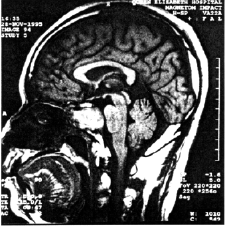A 33-year-old Chinese man was diagnosed
with nasopharyngeal carcinoma (NPC) in November
1982. The investigations revealed anterior
extension of tumour from the nasopharynx to the
left posterior nasal cavity. No bony erosion of
the skull base was found. There were no neck
node metastases. The disease was therefore Stage
II (T2NOMO) according to Ho's staging system.
Radical radiotherapy was then administered,
using a three-field technique (one anterior and
two opposing lateral facial fields ). All the
fields were equally weighted and eye shields
were used for all three. A dose of 66 Gy was
given. The neck was not treated
prophylactically. The treatment was completed
uneventfully in February 1983.
In July 1986, the patient complained of poor
memory and suffering from feelings of
insecurity, which characterized temporal lobe
epilepsy. A CT scan of the brain revealed a
small right temporal lobe area of radiation
necrosis appearing as a hypodense lesion. Since
then, he has required intermittent courses of
anticonvulsants to control his temporal lobe
epilepsy (the anticonvulsant therapy has
occasionally been discontinued according to his
wish). He also had postirradiation bilateral
sixth cranial nerve palsies.
In September 1995 he developed frequent
yawning attacks, which came on almost every
10-15 seconds. They were so disturbing that the
patient's speech and attempts at eating were
frequently interrupted. A CT scan of the base of
the skull showed an expansile mass in the
sphenoidal sinus, with erosion of the floor of
the sinus and the basiocciput. Subsequent MRI
revealed that the sphenoidal sinus was expanded
and filled with material of intermediate signal
intensity on TI WI images and hyperintense on
T2WI, which was suggestive of a mucocoele. The
sphenoidal mass was also found to be compressing
the pituitary hypothalamic region. Simple
surgical drainage and sphenoidal sinus biopsy
were, performed, yielding chronic inflamed
tissue without any evidence of malignancy. There
were no more yawning attacks after the surgical
drainage.
In july 1996, the yawning attacks recurred,
although they were less frequent. A CT scan of
the nasopharynx and the base of the skull showed
a recurrence of the sphenoidal mucocoele.
Surgical drainage once again successfully
stopped the yawning and there was no recurrence
in the next 6 months.
DISCUSSION : The late complications
following radiotherapy in patients with NPC are
well documented. Neurological and
endocrinological complications are usually
discussed at greater length than others.
Radiation-induced sinusitis, caused by scarring
and obstruction of the sinuses is often
overlooked or neglected, leading to the
under-reporting of this complication.
Sphenoidal, ethmoidal and maxillary sinuses are
all included in the radiation portals.
Osteoradionecrosis, and even radiation induced
osteosarcoma, of the maxillary sinus have been
reported in the literature. Porter have shown a
significant increase in mucosal abnormalities in
the paranasal sinuses as revealed by serial CT
scans before and after radiotherapy in patients
with NPC. Indeed, the relatively rare phenomenon
of a sphenoidal sinus mucocoele developing after
radiotherapy in a patient with NPC has been
reported in a Chinese man who presented with
blurring of vision in both eyes, which was
probably due to compression of the optic chiasma
by the mucocoele.
We now report another Chinese patient who
developed a sphenoidal mucocoele 13 years after
radiotherapy. There was compression of the
pituitary hypothalamic region, giving rise to
contirmous bouts of yawning. The yawning
attacks stopped upon successful drainage of the
sphenoidal mucocoele.
The purpose, physiology and neuroanatomical
pathways of yawning remain a mystery. The
literature, which is mostly based on animal
studies, suggests that this involuntary act is
controlled through the complex imegration of
dopaminergic, cholinergic and
catecholaminemediated pathways, with the
hypothalamus, brainstem and medulla oblongata as
the postulated centres of control. In this
patient, compression of the pituitary
hypothalamic region caused continuous bouts of
yawning. which were disturbing to the patient.
Relief of the pressure after surgical drainage
of the mucocoele stopped further attacks of
yawning.




